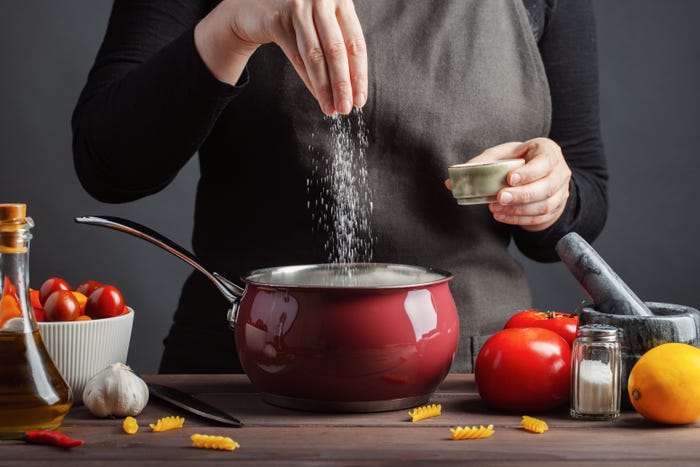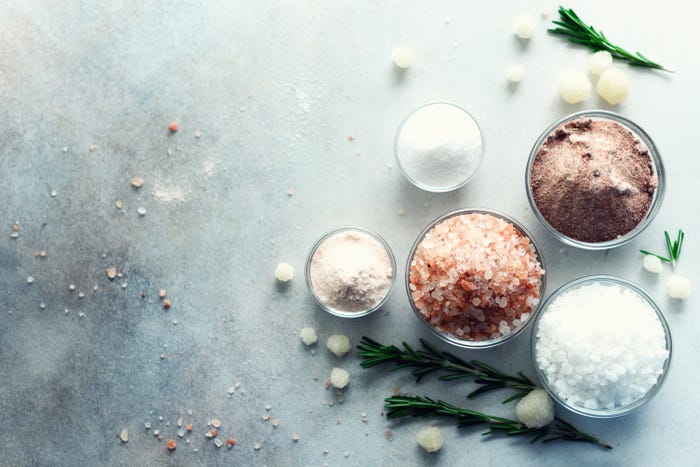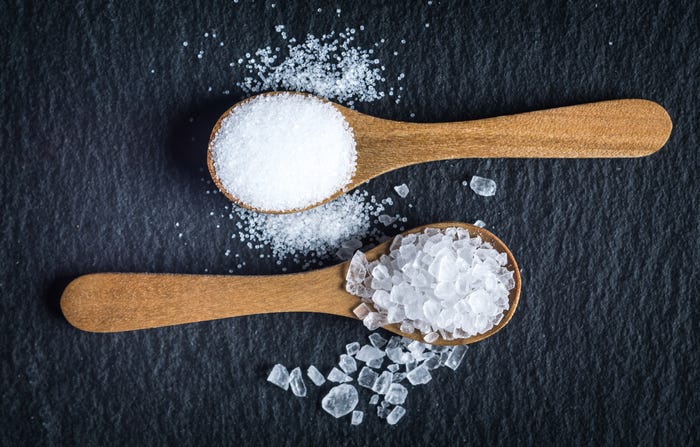Unlocking salt’s secrets: The intersection of flavor, food science
Salt, a once-deemed health scourge, has evolved to a celebrated ingredient in food science. Industry professionals highlight its nutritional value and culinary significance, as well as smarter salting strategies amidst ongoing debates about its health implications.

At a Glance
- While previously criticized for health risks, recent studies have cast doubt on salt’s negative effects.
- Salt is both a flavor enhancer and fundamental nutrient, essential for electrolyte balance and preservation.
- Food scientists are developing ways to use salt more effectively, like using specific shapes and sizes to deliver flavor.
For generations, salt — or, more accurately, its constituent sodium — has struck experts as such a health scourge that the Center for Science in the Public Interest branded it “one of the deadliest ingredients in the U.S. food supply.”
But does unassuming sodium chloride really deserve such a slanderous smear?
After all, reevaluations of the evidence suggest that salt’s risks may not be so categorically cut-and-dried. While debate about its perils persists, we can confidently state that salt — in reasonable doses — supplies a necessary nutrient and has been part of the human diet ever since we’ve been human.
So, is it time to celebrate salt? “Absolutely,” Juliana Biederman, associate marketing manager at Cargill Salt, said. “Salt’s gone from being just an ingredient to being a key experiential element with a wide-ranging impact on how foods are perceived as healthy, indulgent or tasty. Salt is a staple, yes, but now it can be so much more.”
Shifting sensibilities
That’s quite a turn of events for a “deadly” ingredient. Proprietary Cargill research suggests that contemporary consumers do view some types of salt — specialty salts like sea, kosher and pink Himalayan, in particular — as “more desirable,” according to Biederman, who added that “including these more ‘premium’ salts as an ingredient elevates the total product offer in consumers’ minds and turns eating into an experience.”
That makes sense to Nick Mendoza, founder and CEO of Neptune Snacks, makers of sustainable, chef-inspired fish jerkies. “‘Salt’ is beginning to feel less like a bad word in the food and culinary space these days and I think there’re a couple factors behind its revival,” he said.

Celebrating salt
First, of course, is its undisputed nutritional value. “In the right quantities, salt is great,” Mendoza explained. “It provides a fundamental electrolyte — hence our strong attraction to it.”
Where the “predicament” lies, however, is in the fact that salts, like fats, weren’t nearly so abundant in historical human diets. It’s only been within the past half-century that “they’ve been snuck into everyday foods, in copious quantities,” according to Mendoza.
“This era of high-inclusion, low-detection sodium in manufactured foods — where it served as a cheap and effective flavor and texture enhancer — was largely what gave rise to the war on salt,” he said. “But in the last decade or two, food manufacturers responded with lower-sodium products, particularly in the natural channel.”
That freed a new generation of consumers to “come of age” minus their parents’ concerns around sodium, Mendoza claimed — a maturation that coincided with the aforementioned studies “casting doubt on how harmful salt actually is.”
The upshot? “It’s easier to celebrate salt as a flavor now that it’s a bit less likely to be lurking in our processed foods,” he said.

Premium panache
It’s even easier to celebrate it given how much panache salt’s savvy use brings to foods.
Formulators are following chefs’ leads here, exploring specialty salts’ capacity “to recreate culinary experiences,” Jordan Timm, R&D manager at Cargill Salt, said. “A cracker made with sea salt from a place consumers aspire to visit, or a chocolate confection topped with a pink salt from the Himalayas, stands out in the marketplace and can command a more premium price.”
Both also offer a case study in how “an ingredient’s origin story matters to consumers and can have a positive impact on purchase decisions,” she said.
Fundamental factor
Mendoza agreed. “Salt just feels more likely to elicit an ‘Ooh’ these days,” he said. “That’s partly why Sea Salt & Juniper was the first flavor we launched.
“Salt is totally fundamental to our products,” he explained. “The salt and coconut sugar in our marinade serve as natural preservatives, binding water molecules for moist, shelf-stable jerky.” Even better, they add potent flavor. And as far as he’s concerned, “There really is no other way to do it.”
“This method of preserving fish and meat goes back thousands of years in cultures all over the world,” Mendoza said. “The Vikings set sail to distant, unknown lands in longboats laden with dried fish, and Roman legions marched to battle with salted tuna jerky in their kit bags.” Hieroglyphics even depict ancient Egyptians preparing salted fish.
Within limits
Yet while salt’s history is august, “Research maintains that excessive sodium consumption can be linked to negative health consequences,” Timm said, despite evidence to the contrary.
Though current Dietary Guidelines for Americans recommend that adults limit sodium intake to 2,300 mg daily, Americans consume closer to 3,400 mg, according to Timm, “with more than 70% of an individual’s total sodium intake coming from commercial food preparation or manufactured products.”
So, formulators can play a unique role in bending that curve, and smarter salting strategies make a great start.

Smart salting
For example, particle size and shape “have a big impact on how consumers perceive salty tastes,” Timm said. Cargill’s Alberger salt range leverages that impact with its “multifaceted, hollow-pyramid and cube-shaped crystals,” she added, which deliver “a more intense salty upfront flavor” that lets formulators use less salt while maintaining finished-product taste.
“Consumers perceive products to be saltier than they actually,” Timm said. While achievable sodium reductions vary by application, Cargill found that using Alberger salt in chip toppings can cut said toppings’ sodium content by up to 20% without requiring any change to the ingredient statement.
“Potassium salt is another tool we use to help reduce sodium, and again, we’ve found that adjusting its particle size and shape lets us achieve greater reductions,” Timm explained. Exhibit A: The “extremely fine” particle size of Cargill’s Potassium Pro Ultrafine permits quick dissolution, with company research suggesting that it produces the salty taste consumers expect sans bitter and metallic notes associated with larger, potassium salt particle sizes.
“As an added benefit, potassium salt can be a source of potassium, an under-consumed nutrient that’s known to counter the effect of sodium on blood pressure for individuals with pre- or hypertension,” Timm said.
Deadly? Sounds more like healthy living.
About the Author
You May Also Like

